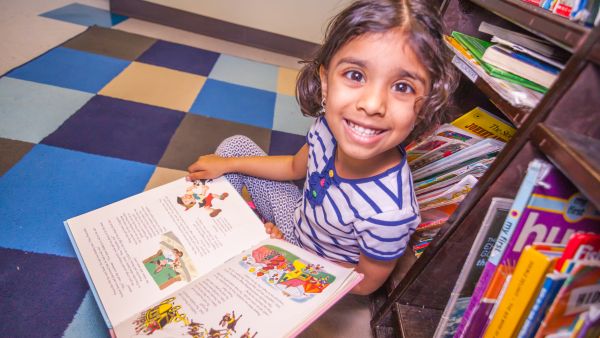
An avid reader of non-fiction adores learning and accumulating information. An avid reader of fiction is someone who loves story, narrative, and the subtleties of language. Both develop large vocabularies and whip-smart comprehension skills. Yes, children who read often score well on standardized tests in school, but that’s an incidental perk compared to the long-term benefit of being able to easily comprehend, absorb, and process information, no matter what they’re reading.
Check out these 7 steps to raising an avid reader.
Set Aside Some Time Every Day
Time is our most limited resource. How we spend it is a matter of priorities. By scheduling a period of time dedicated to reading, like right before bedtime, you’re telling your children that the act is precious and important.
Keep Books In The Home
A house full of books is a house full of readers. If a child has easy access to a shelf full of age-appropriate books, he or she will be as curious about them as about any other toy. If space and resources limit this possibility, make a weekly trip to the library and bring home an armful. Make sure you bring some books home for yourself, too, to model happy reading behavior.
Let Them Choose
So much of a young child’s life is out of their immediate control. When it comes to books, give them the gift of choice. You may have no interest in monster cars or tales of bratty kids, but if those subjects are age-appropriate and have seized your child’s interest, roll with it for the sake of the greater purpose.
Accommodate Your Child’s Skills And Learning Style
There will come a time when your child will have to grapple with 19th-century prose, but best not bore them while they’re very young. While some toddlers may sit quietly through a long, elaborate, high-language story, others may need the additional stimulation of puppets, peel-and-stick stickers, or buttons to push for sound effects. Children are happy to learn when they’re engaged in their particular learning style, so go with the flow.
Also, keep up with your child’s growing skills by introducing more difficult material. That doesn’t mean chucking the books he loves. Rather, add in a few higher-level books so that he’s challenged, but not to the point of frustration.
Be Prepared To Re-Read
Every child has a favorite book. You’ll know what it is because he’ll make you read it over and over. The repetition serves a vital learning purpose. Hearing the words while watching the symbols on the page helps them connect those symbols to sounds as well as develop a vocabulary of sight words. Rhyming stories, such as anything by Dr. Seuss, are particularly good for early pre-readers like toddlers and preschoolers.
Ask Lots Of Questions
Reading comprehension, one of the most important academic skills, takes some time to develop. It requires a growing vocabulary, analytical dexterity, and an ability to step out of the narrative to see the bigger picture.
Help your child develop these skills by verbally engaging her with the story. Using simple words, ask your child to predict what will happen next, who he thinks is the culprit, or why a character is doing something. Can you relate the story to a place where the child has been, or an event that the child has experienced? Make those connections so that your child will understand that some stories have a greater meaning.
Look Beyond The Pages
Books aren’t the only place where reading happens. Encourage your child to use his skills in everyday life. As he becomes familiar with letters and numbers, play “I Spy” games so he can find them in the world around him. Play board or video games that encourage sight reading. Leave him post-it notes with silly drawings and simple words to encourage the connections.
Children learn best when they love what they’re doing. Start them young and they’ll enjoy a lifetime of reading.





















